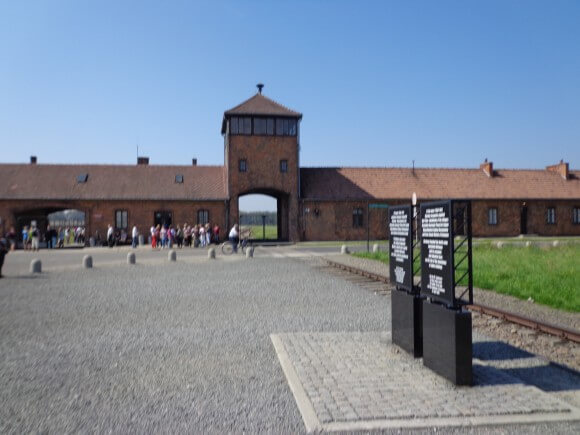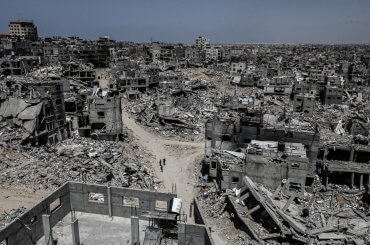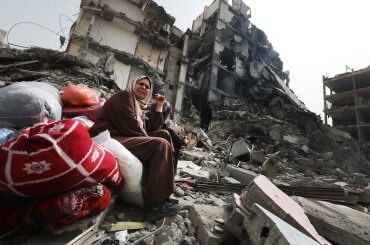A few weeks ago I traveled to Poland. The purpose of my trip was to visit Auschwitz, the infamous labor (Auschwitz 1) and extermination camp (Auschwitz 2 Birkenau) where over one million human beings were murdered, the vast majority of whom were Jews. Before I left the few people I told that I was going asked me why. Why would I go there? What’s the point? I still get the same question now when people ask me where I’ve traveled to lately.
Why did I go? I think the answer is I was drawn to that place to see how I would react, both emotionally and intellectually. Would visiting Auschwitz force me to reconsider my position on the State of Israel and my opposition to the type of Zionism that drives it? Would standing in the one extant gas chamber at Auschwitz 1 force me to consider my luck at having been born a Jew in 1976 in New York as opposed to 36 years earlier somewhere in Europe and therefore change my political values?
I landed at Krakow’s Pope John Paul II airport on a damp and dreary day, a fitting welcome to Poland, I thought to myself. On the ride into town the driver of my taxi made an ill-advised left turn that could easily have ended very badly. Suffice to say I was uncomfortable from the get go.
I had no firm plans, but I wasn’t ready to go to Auschwitz yet. I spent the next day exploring Krakow. I walked down to the Kazimierz district, the former Jewish quarter that is experiencing a strange sort of revival. There’s a row of Jewish-themed restaurants, I stopped for lunch at one called “Ariel.” I asked the waiter what was good, he said “I recommend the Jewish roast beef.”
I had the Jewish roast beef; my grandmother’s brisket was better.
Later on after visiting the requisite museums and such I went back to my hotel and asked the concierge about going to Auschwitz. It felt awkward asking someone about tours to a Nazi death camp. But there’s a brisk business in tours there, so I put the awkwardness aside.
The next morning I went downstairs at 9:00 to begin my journey to Auschwitz. I skipped breakfast. I got into a van. Inside men with British accents were talking among themselves. One of them said something about Barack Obama not being born in the US. “Not worth it,” I said to myself. The van drove for a couple of minutes to a staging point. We were told to get out. “Salt mine tour that bus,” barked a hefty looking Polish woman. “Auschwitz, that bus,” she pointed towards a minivan. I thought to myself that this is bizarre. My dark side sensed the irony and I snickered to myself. I got onto the small van to Auschwitz.
After a 90 minute drive through the Polish countryside we arrived in the town of Oświęcim. We passed the main train station and a few hotels and pizza restaurants before turning into the parking lot for Auschwitz 1, the labor camp and POW camp. We got off the bus and walked towards a large building. There were lots of people around. By now the sun was out and it was getting very warm. I got a bottle of water while the others did their thing, ten minutes later we walked through the gate.

I have to admit that I didn’t care much for the museum aspect of the tour. I already knew the story and was familiar with the machinery of death and torture the Nazis used. I didn’t want to see exhibits as much as I wanted to experience being at that place and feeling whatever feelings the place evoked. It was hard to focus on what the guide was saying. My mind would wander. I looked out the window and saw that there was a highway running along the back of the camp. There seemed to be a lot of traffic, I wondered what, if anything, the people driving by thought about the place. The exhibits were tedious, I didn’t need an education, I wanted contemplation.
Before leaving camp 1, we stopped at Crematorium 1, the only remaining gas chamber at the entire complex. It was originally a morgue attached to the crematorium but it was converted to a gas chamber by way of Nazi ingenuity. The place shook me to the core. I had studied aspects of the Final Solution in high school and college and I understood what happened to a human body dying of Zykon B poisoning. I thought of the terrible scene(s) that took place in that concrete room. The tortured screams as the victims began to understand the grim reality of their situation. And the silence twenty minutes later and then the mass of tangled bodies, soiled by blood urine and feces (Zyklon B caused its victims to evacuate their bowels.) I had an urge to take a picture but my conscience wouldn’t allow it. So many thousands of people died in this place, snapping a photo felt self-indulgent. Just then our guide asked that no one take pictures. I had had enough of the gas chamber and turned to leave. While walking out I passed a man taking a picture.
We got back into our little van for the 2 kilometer drive to Birkenau. Birkenau was the true death center at Auschwitz. Between 1943 and 1944 the four gas chambers and crematoria there worked nearly nonstop, taking over one million living people and reducing them to their basic chemical compounds – ash.

The iconic main gate of Birkenau came into sight. I was struck by how small it seemed. I had seen literally hundreds of pictures of that gatehouse, the pictures always showing scenes of the selections that took place when transports of Jews arrived from all over Europe. But that’s the thing about that place, everything seems just plain and ordinary, in spite of the enormity of the acts that took place there.
We walked to that main gate and waiting for our guide for this second and final portion of the tour. While we waited I spotted two high-school age young men carrying a large Israeli flag towards the gate. They walked with purpose and had determined looks on their faces. I wondered what they were thinking.
Our guide was a young Polish woman with a very good command of English. We walked through the gate. Immediately she began explaining the history of Birkenau and my mind wandered. Now I saw several young people wearing Israeli flags as if they were shawls and then I understood that these were Israeli high school students on a school trip to Auschwitz. I thought of Yoav Shamir’s documentary “Defamation,” and I shook my head.
We made our way towards the back of the camp where the crematoria were. Our guide kept saying that those “sentenced to death” were murdered in these spaces. I kept thinking that no one really was sentenced to death, not in the way I understand the term. What went on there was a nihilistic orgy of death. Nothing resembling due process resulting in a sentence of death took place there.
We approached the site of Crematorium 2 (all the former crematoria at Birkenau were destroyed, one in a revolt by Jewish prisoners). Next to it is a small pond where we were told the ashes of victims were poured. On the banks of the pond were very small Israeli flags on wooden toothpicks. I had seen enough.

On our way back to the main gate we stopped at what we were told was a women’s barracks for laborers.(Birkenau was unique in the constellation of Nazi death and concentration camps in that as well as being a killing center it also housed thousands of laborers.) “Prisoners woke up at 4:00 AM and roll call went on for three hours,” the guide said. “Every night people would die, the living would have to hold the dead up at roll call because the Germans were meticulous about getting a proper count. It was easier in the winter because they would stick the corpses up in the snow and they wouldn’t have to hold them up.”
I was numb. I left the group and walked back towards the gate alone. On the way I saw more young Israelis. They were hugging each other and sheltering each other under their flag. When I got to the gate I saw that there was a bookstore. I went in. It was a bookstore and nothing else. No trinkets or souvenirs for sale, but a bookstore nonetheless. I wondered what that space was used as when Birkenau was operational. The group eventually made its way back to the gate. I thanked our guide and gave her a generous tip. We walked a few hundred meters back to the minivan, and I felt relieved that we were finished.
On the drive back to Krakow I tried to make sense of what I had seen and felt. To be honest I had no major epiphany. I just felt numb. No major radical change in my worldview regarding Israel or anything. Just the same sense that the best we can do is guarantee equal rights for all and punish those who unlawfully harm others. Ethnic chauvinism as a response to ethnic chauvinism isn’t the answer. It’s a capitulation.
I was very hungry now and I fell asleep. I woke up probably thirty minutes later. We drove by the intersection where that taxi driver had made that almost tragic mistake two days earlier. I exhaled, I knew we were only a few minutes outside of Krakow. Fifteen minutes later we got off the van at the main old town square. I stopped at one of the dozens of outdoor restaurants and sat down at the first empty table I found. I ordered a schnitzel and a large glass of beer. I took out my phone and dialed a number.
“Hi Scott, what’s up?” said the voice on the other end of the line. “I saw what I came to see, can you see if I can get on a flight back to JFK tomorrow?”, I asked. “Let me see,” said the voice. I took a big swig of my beer and waited for the response.


Thank you.
“… I didn’t want to see exhibits as much as I wanted to experience being at that place and feeling whatever feelings the place evoked.”
Exactly what I look to experience whenever I go someplace. No BS and no propaganda offered by Scott, but I felt the horror of the place and what had happened there. Fascinating story-telling that made me feel I was there with Scott.
Thanks Scott,
I wonder when our hosts, Phil and Adam, are going to ‘get on the bus’?
So true, Walid. Superb story-telling. I felt quite numb reading…. to the core of my soul.
“It’s a capitulation” , Scott says. What an insightful comment. Thank you.
I was struck by how normal Auschwitz (I) looked. Just like the barracks it was built as. Could have been any kind of camp, not just the work/death camp it was. Auschwitz II Birkenau on the other and leaves so many horrors in the mind. The housing that looks like a stable. The tiny cement cubicles prisoners were locked into. I scraped my foot on the ground near a dingy pond and found a human tooth. It was clearly a place to temporarily house the dying. The “no crematorium” line of holocaust-denial goes irrelevant when you see how this was built for typhus to finish the job that gas might not.
And also the town of Oświęcim which resents the German name that has been indelible along with the history of what happened nearby.
It was summer and kids were swimming in the stream nearby the town which also runs along a road to the camp.